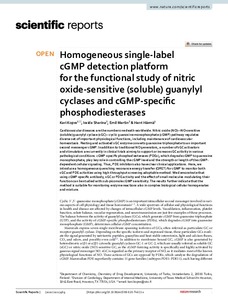Homogeneous single-label cGMP detection platform for the functional study of nitric oxide-sensitive (soluble) guanylyl cyclases and cGMP-specific phosphodiesterases
Kari Kopra; Iraida Sharina; Emil Martin; Harri Härmä
Homogeneous single-label cGMP detection platform for the functional study of nitric oxide-sensitive (soluble) guanylyl cyclases and cGMP-specific phosphodiesterases
Kari Kopra
Iraida Sharina
Emil Martin
Harri Härmä
NATURE RESEARCH
Julkaisun pysyvä osoite on:
https://urn.fi/URN:NBN:fi-fe2021042822555
https://urn.fi/URN:NBN:fi-fe2021042822555
Tiivistelmä
Cardiovascular diseases are the number one death worldwide. Nitric oxide (NO)-NO-sensitive (soluble) guanylyl cyclase (sGC)-cyclic guanosine monophosphate (cGMP) pathway regulates diverse set of important physiological functions, including maintenance of cardiovascular homeostasis. Resting and activated sGC enzyme converts guanosine triphosphate to an important second messenger cGMP. In addition to traditional NO generators, a number of sGC activators and stimulators are currently in clinical trials aiming to support or increase sGC activity in various pathological conditions. cGMP-specific phosphodiesterases (PDEs), which degrade cGMP to guanosine monophosphate, play key role in controlling the cGMP level and the strength or length of the cGMP-dependent cellular signaling. Thus, PDE inhibitors also have clear clinical applications. Here, we introduce a homogeneous quenching resonance energy transfer (QRET) for cGMP to monitor both sGC and PDE activities using high throughput screening adoptable method. We demonstrate that using cGMP-specific antibody, sGC or PDE activity and the effect of small molecules modulating their function can be studied with sub-picomole cGMP sensitivity. The results further indicate that the method is suitable for monitoring enzyme reactions also in complex biological cellular homogenates and mixture.
Kokoelmat
- Rinnakkaistallenteet [27094]
